Knowing how to check your bicycle chain for wear can prevent you from being stranded on the roadside with a broken chain, keep your drivetrain running efficiently, and, in the long run, save you money.
In this guide, we’ll take a look at what chain wear is, why it matters and how to prevent it from costing you money in the long run.
What pieces make up a chain?
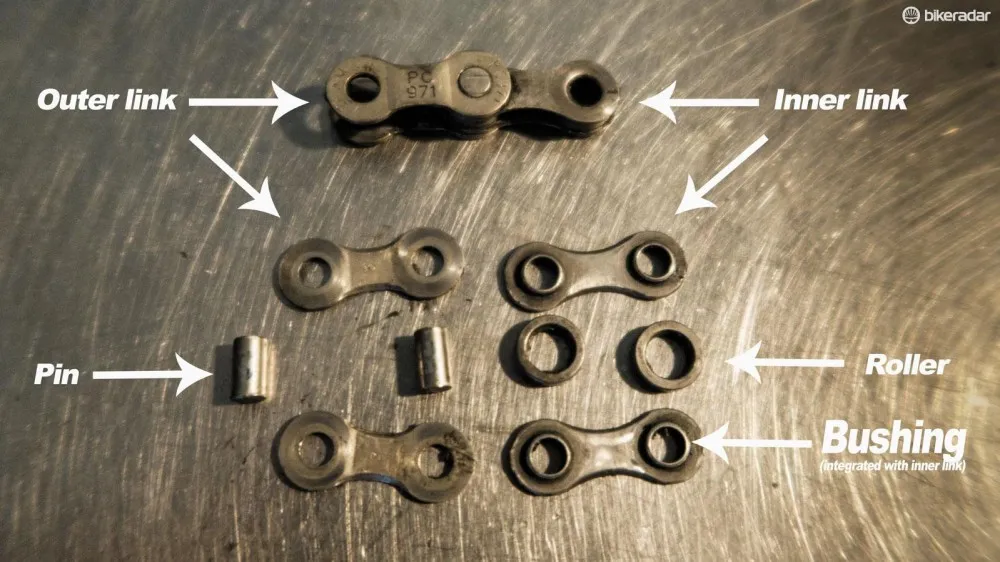
A bicycle chain is made up of lots of individual pieces. These include the pin (also known as the rivet), outer links, inner links, bushing and roller.
On most modern chains, the bushing is integrated with the inner plate and holds in the circular roller.
Each chain link is joined onto the next, alternating between outer plate and inner plate. A whole chain link is commonly thought of as one segment of outer and inner plate together.
A chain has a 0.5in (12.7mm) spacing between pins. This is the chain ‘pitch’ and is an industry standard on multi-speed bikes.
In this article, we're only referring to standard ‘derailleur’-type multi-speed bicycle chains.
What is chain wear?

Chain wear is commonly referred to as ‘chain stretch’, because the chain’s pitch grows in length as it wears. This is the most important type of chain wear, and the growth comes from the bushings wearing with the chain pins. Over time, the inner diameter of these bushings increases and the pins groove out.
It’s often stated that a chain is worn once it reaches one per cent growth from the original 0.5in (12.7mm) pitch.
Another type of chain wear is ‘slop’. This isn’t as easy to measure, but it is common with riders who don’t put a lot of torque into their drivetrain, or perhaps spin a higher cadence.
Worn-out rollers increase the side-to-side play in the chain. As a result, the shifting is sloppier because the shifting ramps of the cassette or chainring need to work harder to derail the chain onto the desired cog.
It’s important though to bear in mind that chain slop won’t wear out other components.
The rate at which a chain wears depends on a plethora of factors. These include the discipline of riding and the terrain, the model of chain, which gears you ride in and how you change gear. Arguably, the most significant factor is how you maintain your chain.
Why should I care about chain wear?
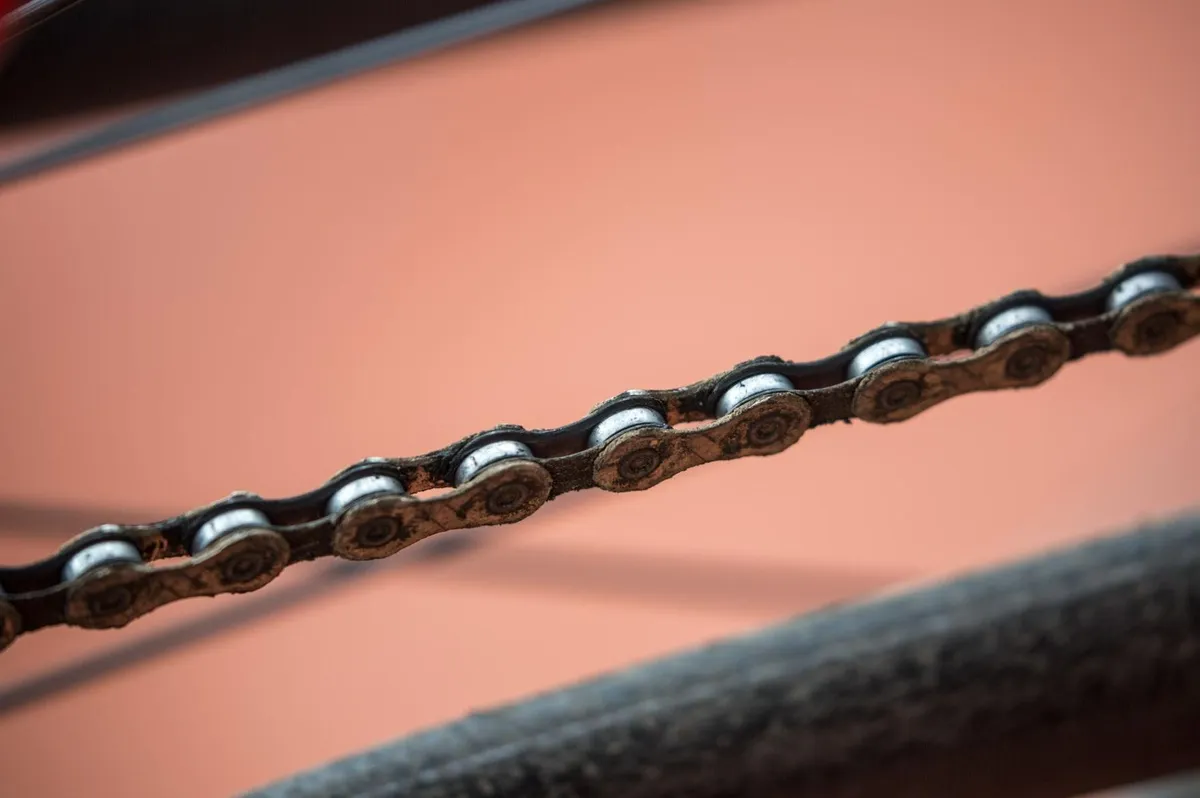
Chain wear will lead to poor shifting and lost efficiency. Additionally, a severely worn chain is weaker, and there’s nothing fun about a snapped chain.
Perhaps most importantly though, chain wear can cost you a lot of money if left too long.
There are knock-on effects for the rest of your bike, too. A worn chain can wear the cassette and ultimately any chainrings on your crankset. Cassettes and chainrings are typically more expensive than chains, so costs can escalate quickly if a worn chain is not replaced in time.
A new chain at a 0.5in pitch is designed to sit deep into the cog. As the pitch increases, the chain rolls higher up on the tooth and causes rapidly increased cog wear as the point of contact is reduced. Too much wear, and the chain will start skipping over the top of the cog.
Provided you replace the chain before it passes its wear limit, it's possible to run multiple chains on your bike without having to replace your cassette or chainrings. For the majority of drivetrains, that is far more economical than having to replace the cassette and chainrings every time you need a new chain. This is especially true when considering the cost of a cassette on some groupsets.
How do I measure a chain for wear?
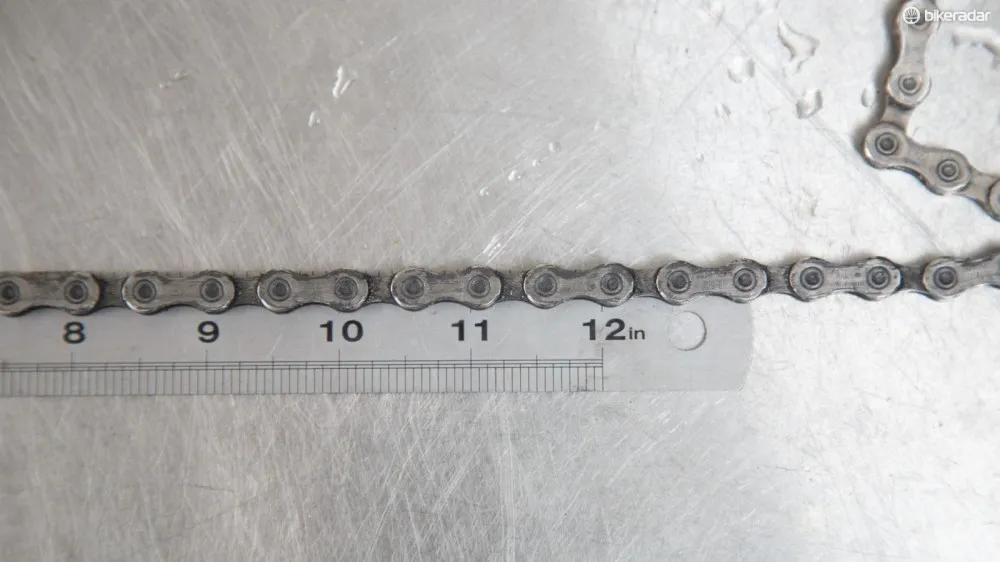
Chain wear is best measured using a specific chain checker tool, but it's possible to use an accurate ruler or tape measure.
Using a ruler, a new chain should measure exactly 12 inches across 12 links, from middle of pin to middle of pin. The number most commonly agreed on for a worn chain is one per cent elongation between links. In reality though, you should replace the chain before this point.
So, therefore, anything past 12 1/16in (0.5 per cent) would be the time to replace a chain. Anything past 12 1/8in (one per cent) has been worn to death and so a new cassette is likely needed.
Holding a ruler perfectly straight while lining it up to measure 1/8in is difficult, and chain checker tools provide a far simpler and quicker 'go or no-go' result.
Whichever way you choose to measure a chain, be sure to not include the quick link, if you have one installed because they wear slower than conventional links.
Typical chain checker tools are the easiest way to check a chain for wear. The tool drops into your chain, giving you a quick 'go' or 'no-go' gauge result.
Different tools are intended to show you different levels of chain wear, showing if the chain has stretched by 0.5 per cent, for instance. Many will be double-sided, giving you two readings.
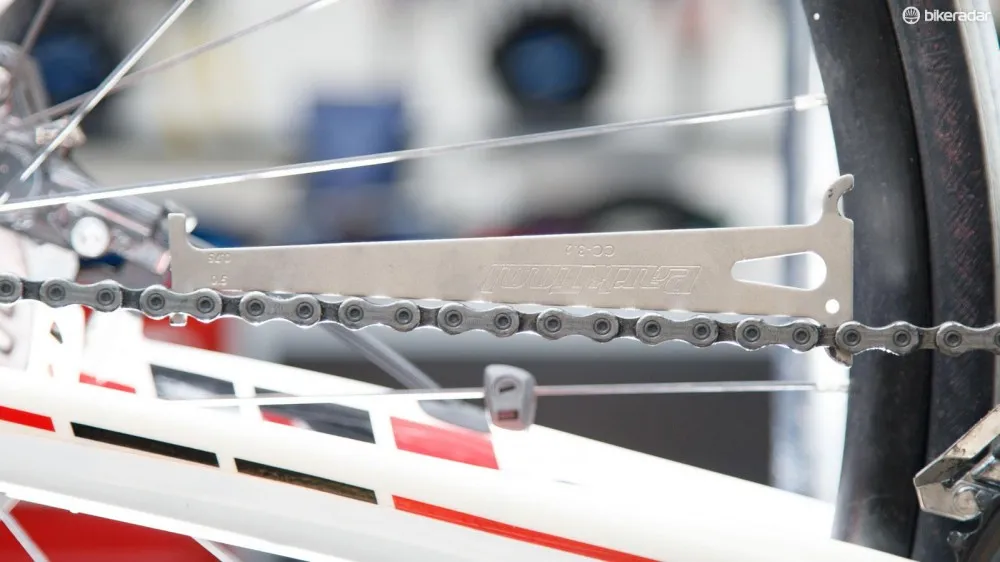
If a chain is worn, the two ends of the tool will fall into the chain links and it will sit flush with the chain.
If the chain is okay, the tool will sit above the chain.
More expensive chain checkers can produce more precise readings. The most expensive tools are digital and work by installing the chain checker into the chain and opening up the tool until it hits the end of the link.
Not all chain checkers are compatible with the Flattop chains SRAM uses on its road and gravel eTap AXS 12-speed drivetrains. This is because the chains use oversized rollers. SRAM has a compatibility document on which tools will work.
How often should I replace my chain?

Different chains will have different wear limits, and with drivetrains now offering up to 13 speeds, there is a lot of variation in how worn a chain can be.
A 6 to 10-speed chain should be replaced when it measures 0.75 per cent on a chain checker. If it is stretched to 1 per cent, the cassette should be replaced with it.
11 to 13-speed chains should be replaced at 0.5 per cent on a chain checker. The chain and cassette should be replaced if it has stretched to 0.75 per cent.
Chains don’t wear evenly, so for the most accurate result, it’s best to take measurements on at least three different parts of the chain.
It’s worth noting that the manufacturer's recommended wear limit can differ from the above.
Unfortunately, riding distance is not an accurate indicator of chain wear, and keeping a check on measurement is the best way to know if you should replace your chain.
Getting into a routine of regularly cleaning your bike chain will stop contaminants building up, which can act as a grinding paste in the drivetrain and accelerate the rate of wear. As well as degreasing and cleaning the chain, you need to dry it and then apply chain lubricant.
It’s worth incorporating checking your chain for wear into your maintenance regime.
You could also wax your chain, which can further protect it from wear-increasing contaminants. However, chain waxing is time-intensive and requires investment in kit and supplies.
What if my chain is already worn?

Exactly how much wear your chain has will dictate your available options. On terribly worn drivetrains, the teeth of the cogs will begin to look hooked from the chain wearing high on them.
If you’re at this point, replacing just the chain isn’t really an option. Instead, you will have to replace the chain, cassette and likely your chainrings.
If you continue to ride with an excessively worn chain, you also run the risk of it snapping.
If your chain is slightly past the wear limit, you may be able to get away with replacing just the chain. Simply fit a new chain and if you experience any skipping on the cassette or chainrings, you know the old chain has worn the cassette and chainring and these now need to be replaced.
If you continue to run a new chain on an old cassette or chainring, the chain will wear prematurely.
There are some exceptions, such as on cheaper bikes, where it's more economical to let the chain and cassette wear together and replace both in one go. It’s worth familiarising yourself with how much the particular components on your bike retail for before deciding your chain-replacement strategy.
What is the best chain checker?
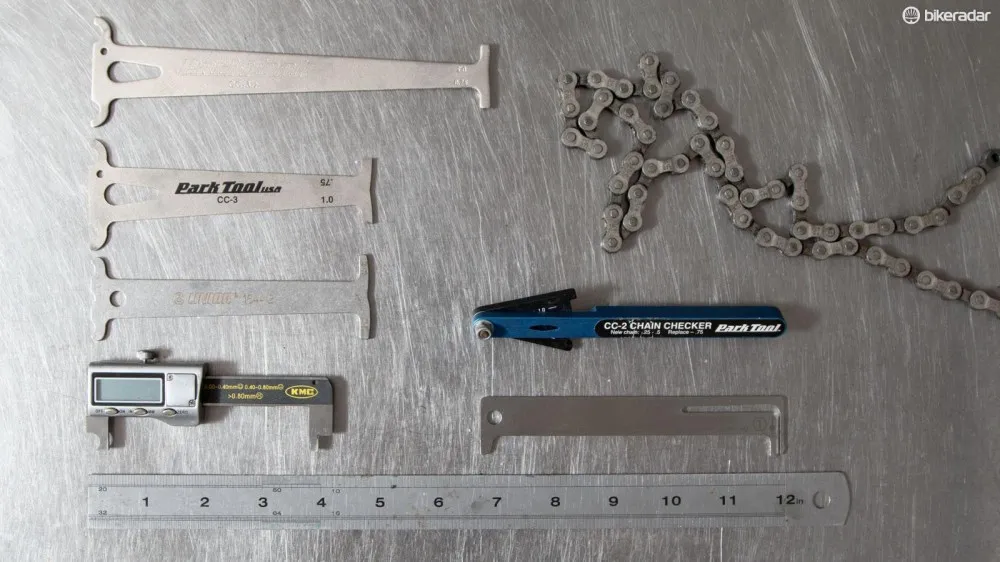
There are strong opinions on what style of chain checkers work, and which ones cause premature wear readings. Some claim chain checkers are susceptible to false reading by taking into account roller movement by pushing the pieces in opposite directions.
Drop-in style chain checkers from the likes of Shimano and Pedro isolate roller wear by measuring pin wear in the same direction. They are viewed widely as being accurate across all brands and speeds of chains.

Chain tension can affect the wear reading because the more tension you put through it, the higher the wear reading. On some of the newer style of chain-checking tools, such as Park Tool’s CC-4, the reading the tool supplies is also subject to hand pressure.
A dirty, or thickly lubricated chain will likely show as less worn than a clean chain, so for the most accurate wear reading, it’s worth cleaning your chain.
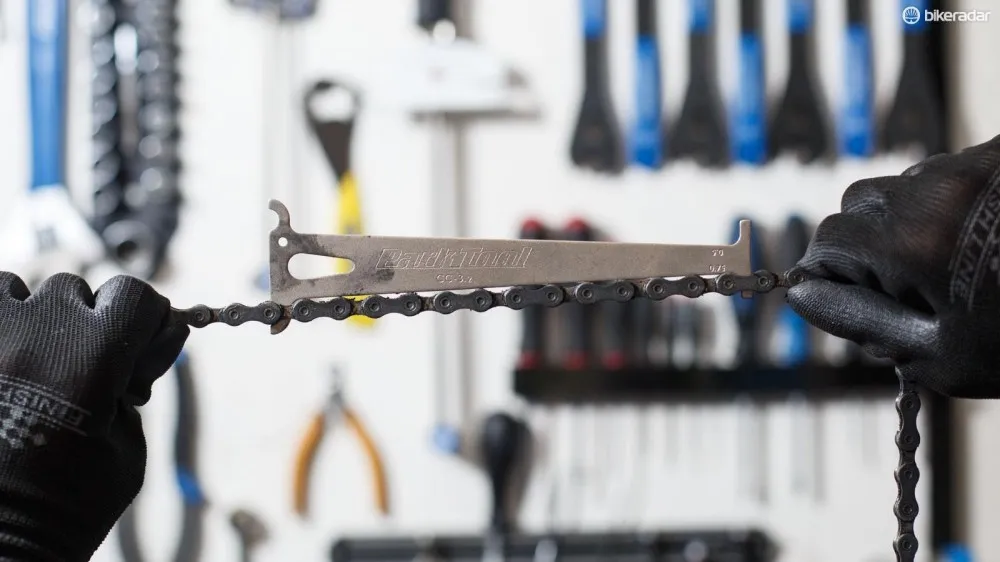
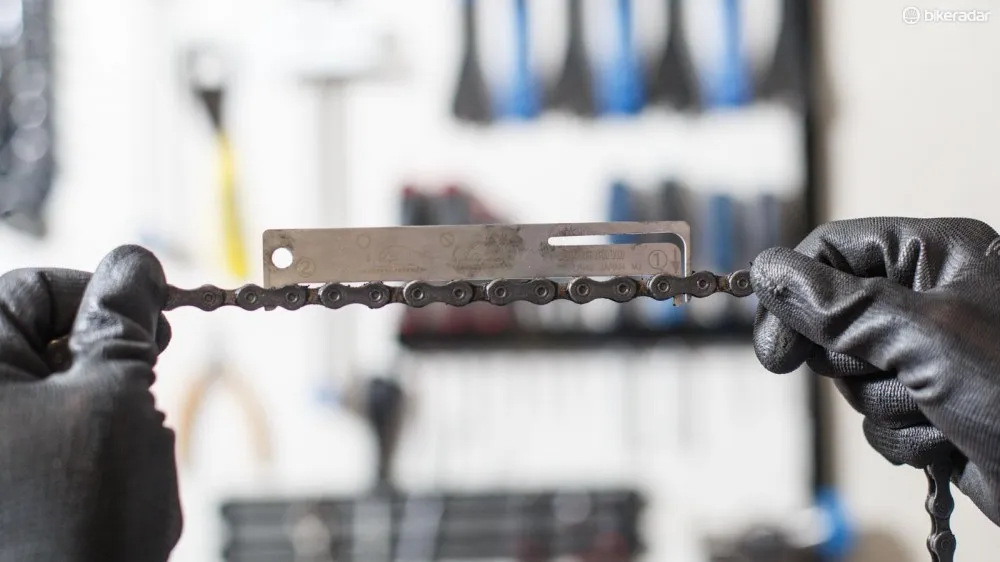
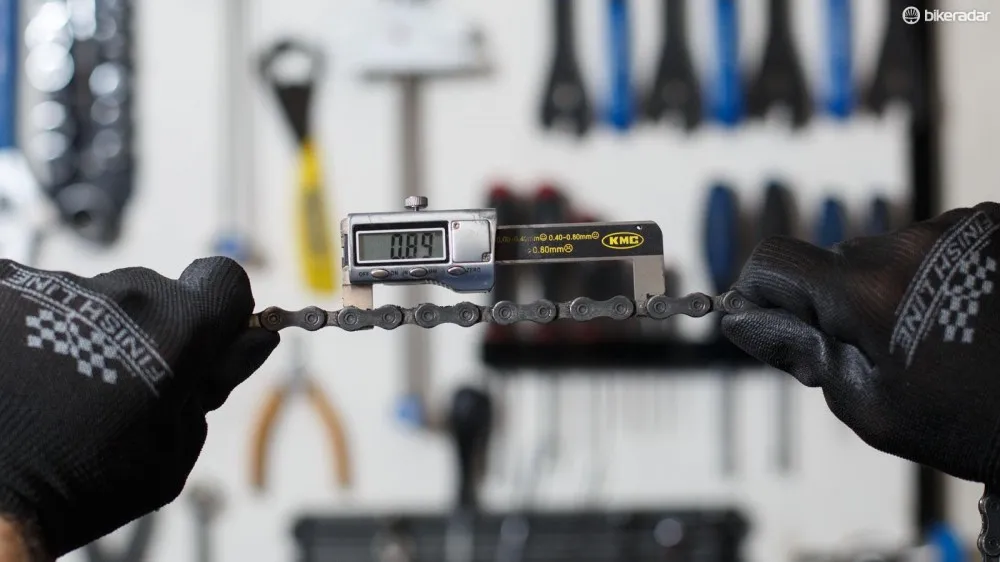
When comparing Shimano’s CN-42 checker to the likes of a Park Tool CC-3.2 and a KMC Digital gauge, we found the results to be broadly similar, signalling wear at about the 0.75 per cent point. For the identical Shimano Ultegra 11-speed chain, the KMC digital chain checker showed 0.89 per cent.
Ultimately, it's more accurate to check a chain for wear using a specific tool than not to. A drop-in style tool will do the job well for almost all riders, but others will deem the increased accuracy of a digital gauge worth the price.
